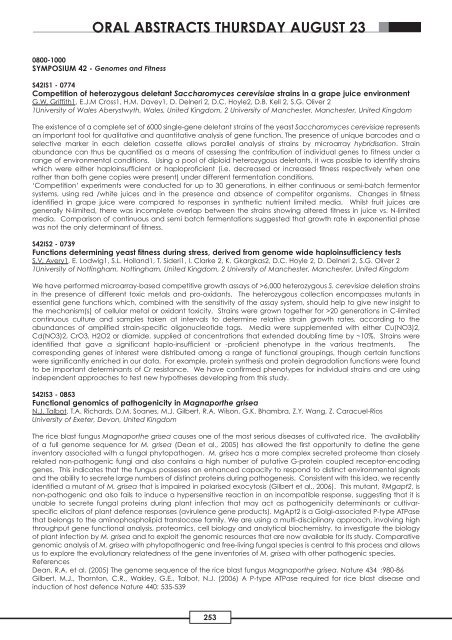Handbook Part 2 - International Mycological Association
Handbook Part 2 - International Mycological Association
Handbook Part 2 - International Mycological Association
You also want an ePaper? Increase the reach of your titles
YUMPU automatically turns print PDFs into web optimized ePapers that Google loves.
ORAL ABSTRACTS THURSDAY AUGUST 23<br />
0800-1000<br />
SYMPOSIUM 42 - Genomes and Fitness<br />
S42IS1 - 0774<br />
Competition of heterozygous deletant Saccharomyces cerevisiae strains in a grape juice environment<br />
G.W. Griffith1, E.J.M Cross1, H.M. Davey1, D. Delneri 2, D.C. Hoyle2, D.B. Kell 2, S.G. Oliver 2<br />
1University of Wales Aberystwyth, Wales, United Kingdom, 2 University of Manchester, Manchester, United Kingdom<br />
The existence of a complete set of 6000 single-gene deletant strains of the yeast Saccharomyces cerevisiae represents<br />
an important tool for qualitative and quantitative analysis of gene function. The presence of unique barcodes and a<br />
selective marker in each deletion cassette allows parallel analysis of strains by microarray hybridisation. Strain<br />
abundance can thus be quantified as a means of assessing the contribution of individual genes to fitness under a<br />
range of environmental conditions. Using a pool of diploid heterozygous deletants, it was possible to identify strains<br />
which were either haploinsufficient or haploproficient (i.e. decreased or increased fitness respectively when one<br />
rather than both gene copies were present) under different fermentation conditions.<br />
‘Competition’ experiments were conducted for up to 30 generations, in either continuous or semi-batch fermentor<br />
systems, using red /white juices and in the presence and absence of competitor organisms. Changes in fitness<br />
identified in grape juice were compared to responses in synthetic nutrient limited media. Whilst fruit juices are<br />
generally N-limited, there was incomplete overlap between the strains showing altered fitness in juice vs. N-limited<br />
media. Comparison of continuous and semi batch fermentations suggested that growth rate in exponential phase<br />
was not the only determinant of fitness.<br />
S42IS2 - 0739<br />
Functions determining yeast fitness during stress, derived from genome wide haploinsufficiency tests<br />
S.V. Avery1, E. Lodwig1, S.L. Holland1, T. Sideri1, I. Clarke 2, K. Gkargkas2, D.C. Hoyle 2, D. Delneri 2, S.G. Oliver 2<br />
1University of Nottingham, Nottingham, United Kingdom, 2 University of Manchester, Manchester, United Kingdom<br />
We have performed microarray-based competitive growth assays of >6,000 heterozygous S. cerevisiae deletion strains<br />
in the presence of different toxic metals and pro-oxidants. The heterozygous collection encompasses mutants in<br />
essential gene functions which, combined with the sensitivity of the assay system, should help to give new insight to<br />
the mechanism(s) of cellular metal or oxidant toxicity. Strains were grown together for >20 generations in C-limited<br />
continuous culture and samples taken at intervals to determine relative strain growth rates, according to the<br />
abundances of amplified strain-specific oligonucleotide tags. Media were supplemented with either Cu(NO3)2,<br />
Cd(NO3)2, CrO3, H2O2 or diamide, supplied at concentrations that extended doubling time by ~10%. Strains were<br />
identified that gave a significant haplo-insufficient or -proficient phenotype in the various treatments. The<br />
corresponding genes of interest were distributed among a range of functional groupings, though certain functions<br />
were significantly enriched in our data. For example, protein synthesis and protein degradation functions were found<br />
to be important determinants of Cr resistance. We have confirmed phenotypes for individual strains and are using<br />
independent approaches to test new hypotheses developing from this study.<br />
S42IS3 - 0853<br />
Functional genomics of pathogenicity in Magnaporthe grisea<br />
N.J. Talbot, T.A. Richards, D.M. Soanes, M.J. Gilbert, R.A. Wilson, G.K. Bhambra, Z.Y. Wang, Z. Caracuel-Rios<br />
University of Exeter, Devon, United Kingdom<br />
The rice blast fungus Magnaporthe grisea causes one of the most serious diseases of cultivated rice. The availability<br />
of a full genome sequence for M. grisea (Dean et al., 2005) has allowed the first opportunity to define the gene<br />
inventory associated with a fungal phytopathogen. M. grisea has a more complex secreted proteome than closely<br />
related non-pathogenic fungi and also contains a high number of putative G-protein coupled receptor-encoding<br />
genes. This indicates that the fungus possesses an enhanced capacity to respond to distinct environmental signals<br />
and the ability to secrete large numbers of distinct proteins during pathogenesis. Consistent with this idea, we recently<br />
identified a mutant of M. grisea that is impaired in polarised exocytosis (Gilbert et al., 2006). This mutant, ?Mgapt2, is<br />
non-pathogenic and also fails to induce a hypersensitive reaction in an incompatible response, suggesting that it is<br />
unable to secrete fungal proteins during plant infection that may act as pathogenicity determinants or cultivarspecific<br />
elicitors of plant defence responses (avirulence gene products). MgApt2 is a Golgi-associated P-type ATPase<br />
that belongs to the aminophospholipid translocase family. We are using a multi-disciplinary approach, involving high<br />
throughput gene functional analysis, proteomics, cell biology and analytical biochemistry, to investigate the biology<br />
of plant infection by M. grisea and to exploit the genomic resources that are now available for its study. Comparative<br />
genomic analysis of M. grisea with phytopathogenic and free-living fungal species is central to this process and allows<br />
us to explore the evolutionary relatedness of the gene inventories of M. grisea with other pathogenic species.<br />
References<br />
Dean, R.A. et al. (2005) The genome sequence of the rice blast fungus Magnaporthe grisea. Nature 434 :980-86<br />
Gilbert, M.J., Thornton, C.R., Wakley, G.E., Talbot, N.J. (2006) A P-type ATPase required for rice blast disease and<br />
induction of host defence Nature 440: 535-539<br />
253









